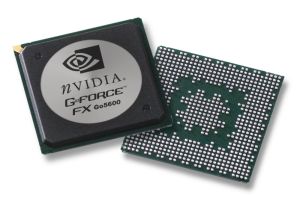GeForce FX Go

As in the past, NVIDIA are introducing mobile variants of the desktop parts recently released. However, with the introduction of NV34 and NV31 NVIDIA have segmented the desktop market with three discrete chips with NV30 (GeForce FX 5800) at the high end, NV31 (5600) in the mid range, and NV34 (5200) at the low end. Obviously laptops are not quite able to cope with the very high end NV30, but both NV31 and NV34 will get mobile variants in the form of GeForce FX Go5200 (NV34M) and GeForce FX Go5600
Being based on the desktop variants from the NV3x line, the new new GeForce FX Go products boast the full range and flexibility of the CineFX architecture, including DirectX9 functionality. This means that the full Floating Point precision, with its higher dynamic ranges which result in the effects dubbed as "Cinematic Rendering", and the increased programmability of the Shader pipeline, exposed by DX9's Extended Vertex Shader 2.0 and Pixel Shader 2.0, are all available in these mobile chips.
Let's take a look at what these parts are comprised of:
| GeForce FX Go5200 | GeForce FX Go5600 | |
| Silicon Process | TSMC 150nm | TSMC 130nm |
| Operating Frequency | Up to 300Mhz | Up to 350MHz |
| Rendering Pipelines | 4 (1.2G pixels/sec) | 4 (1.4G pixels/sec) |
| Memory Frequency | 300MHz | 350MHz |
| Memory Interface | Dual Channel 128-Bit DDR 9.6GB/s | Dual Channel 128-Bit DDR 11.2GB/s |
| Memory Optimisations | ZCull | ZCull ZCompress Colour Compress |
| Host Interface | AGP8X | |
| DirectX Compliancy | DirectX9 Pixel Shader 2.0 Extended Vertex Shader 2.0 Extended | |
| Textures Per Pass | 16 (over multiple cycles) | |
Both of these parts, along with GeForce4 448/488 Go (based on the updated NV18M), are pin compatible, meaning notebook vendors can have several configurations of the same notebook, but with varying degrees of video processing power.
NVIDIA have also boosted the video processing capabilities of GeForce FX Go. Here's a rundown on the features these chips support:
| GeForce 4 Go | GeForce FX Go | |
| Motion Compensation | Y | Y |
| iDCT | Y | Y |
| Graphics Gamma | Y | Y |
| Overlay Gamma | N | Y |
| Overlay | 5, 3 Tap | 5, 3 Tap |
| De-interlacing | B & W | Adaptive |
| HDTV support out | N | Y |
| Video antialiasing | N | Y |
| MPEG2 encode assist | N | Y |
| Digital Vibrance | Y | Y |
| Video mirror | Y | Y |
| VMR support | Y | Y |
Being a notebook part, battery power is of critical concern and so NVIDIA have updated GeForce FX Go's power regulation features to Powermizer version 3.0, which shares many similarities with previous versions. In the Powermizer control panel users will be able to select 3 modes of operation: Maximum Performance, Balanced, and Maximum Battery Saving. In Maximum performance mode, this essentially operates as a desktop discrete part, paying no concerns about power usage and just creating the maximum performance regardless of any factors. The Balanced mode trades some frames per second, where the game performance may exceed the refresh rate, to conserve power, and it also makes sure that as much load as possible is placed on the graphics processor to keep CPU utilisation to a minimum. In Maximum Battery Saving mode the graphics chip is clocked to its minimum level to ensure battery longevity.
Related PR:
- NVIDIA mobile GPUs adopted by top notebook manufacturers
- NVIDIA first to bring Cinematic GPUs for Notebook Computers
- NVIDIA GeForce Go Products Fully Support New Intel® Centrino
- NVIDIA And AMD Deliver Ultimate Mobile Computing Platform

